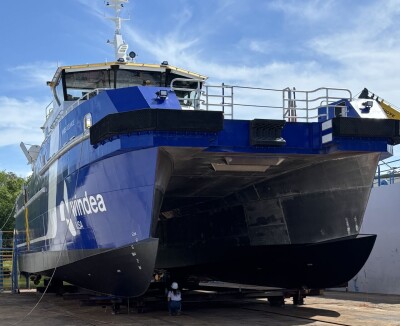Shipbuilder Vigor has begun low rate initial production (LRIP) on the Maneuver Support Vehicle (Light)(MSV(L)) vessel at its facility in Vancouver, Wash. The new generation 117’x28’ U.S. Army landing craft is replacing the Landing Craft Mechanized 8 (LCM-8), a design that now dates back decades to the Vietnam War era of the 1960s-70s.
Vigor, a Titan company, completed and launched the prototype vessel, SSG Elroy F. Wells, in 2022. The next phase of the $1 billion contract will employ more than 180 skilled workers to support the project over the next five years, according to Vigor officials.
“Beginning this work represents a milestone for the Army, for Vigor, and for our employees,” said Jayson Robinson, Vigor’s vice president of fabrication. “It is a credit to the great work of our team over the last several years and the partnership with the Army to have the opportunity to take what we have learned from the prototype and build the next generation of landing craft. Our employees are incredibly proud to support our national defense and our customer’s critical mission.”
The MSV(L) landing craft features an aluminum tribow monohull to provide superior maneuverability and stability in high sea states, in both coastal littoral waters, and on inland waterways to support Army land operations. Vigor officials say the design “is a natural evolution of the BMT Caimen-90, leveraging more than a decade of extensively tested performance and adapted by the Vigor-BMT team to meet U.S. Army requirements.”
Vigor was originally awarded the contract in 2017 and secured the Vancouver, Wash., facility to complete the prototype, multiple vessels under low rate production, and several more over ten years. The vessel is designed to support Army mariners and their payload in even the most difficult environments due to its state-of-the-art maneuverability and stability.
After undergoing sea trials throughout 2023, Vigor and the Army completed the DD 250 handoff of the prototype vessel in February and began planning for production of future vessels. The next phase of fabrication began this week and will continue for the next five years.
“This project will not only improve the Army’s capabilities, it provides more than 180 family wage jobs here in Vancouver,” Robinson said. “We are honored to have been selected for this work and committed to providing a quality, reliable vessel to our customer.”
The MSV(L) can achieve speed of 21 knots fully laden with cargo – up to 85 tons including Army main battle tanks – and a top speed over 30 knots. Three 2,600 hp engines drive waterjets over a range of more than 360 miles. That's around twice the range and laden speed of the old LCM-8.
A raised center jet and 4-foot (1.2 meter) draft when fully laden enable the MSV(L) to make landings on the shallowest beaches, according to Vigor.
 rendering.jpg.medium-cropped.800x500.jpg)


.jpg.medium-cropped.800x500.jpg)


